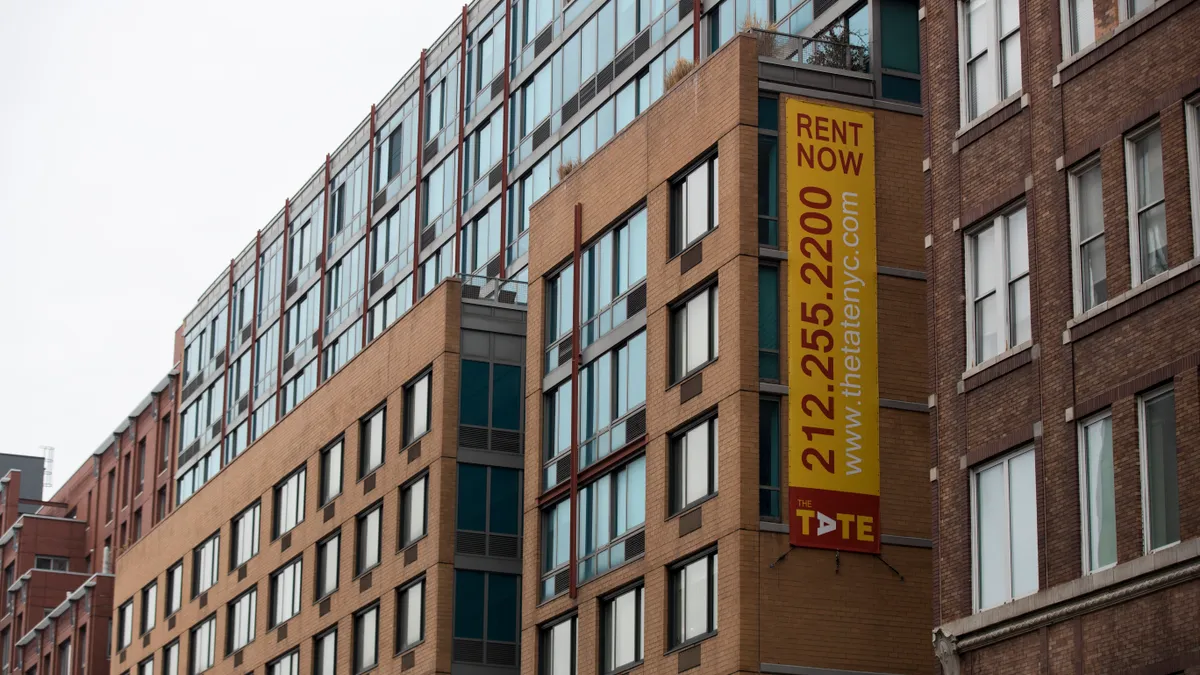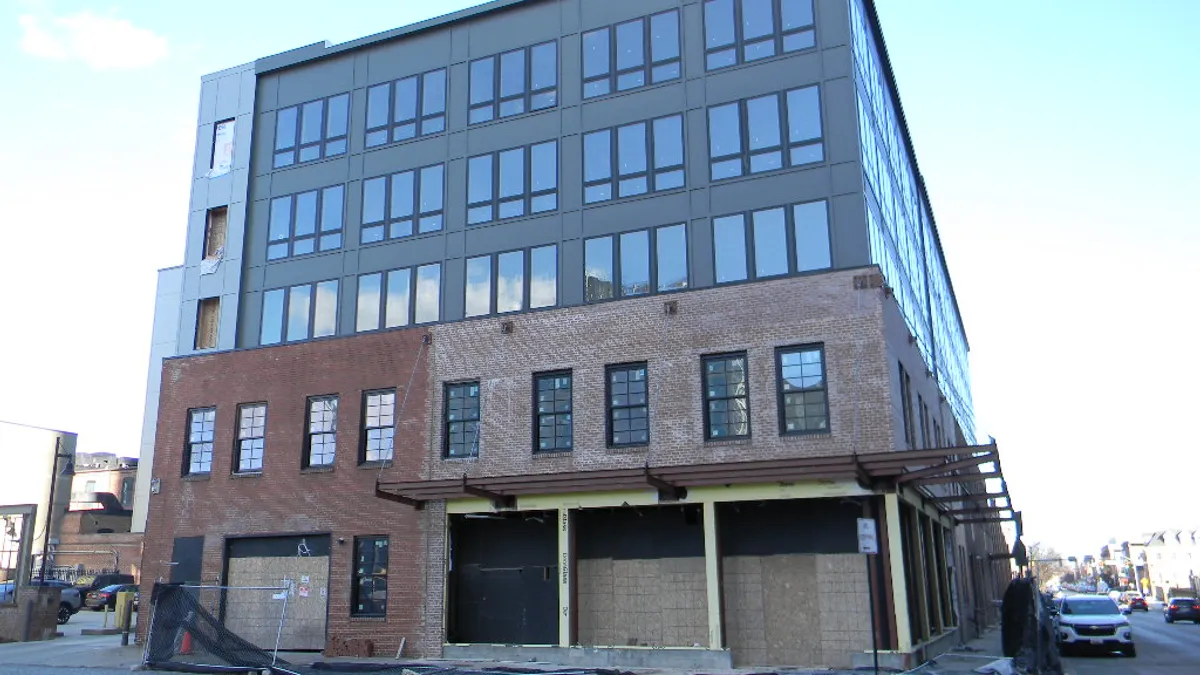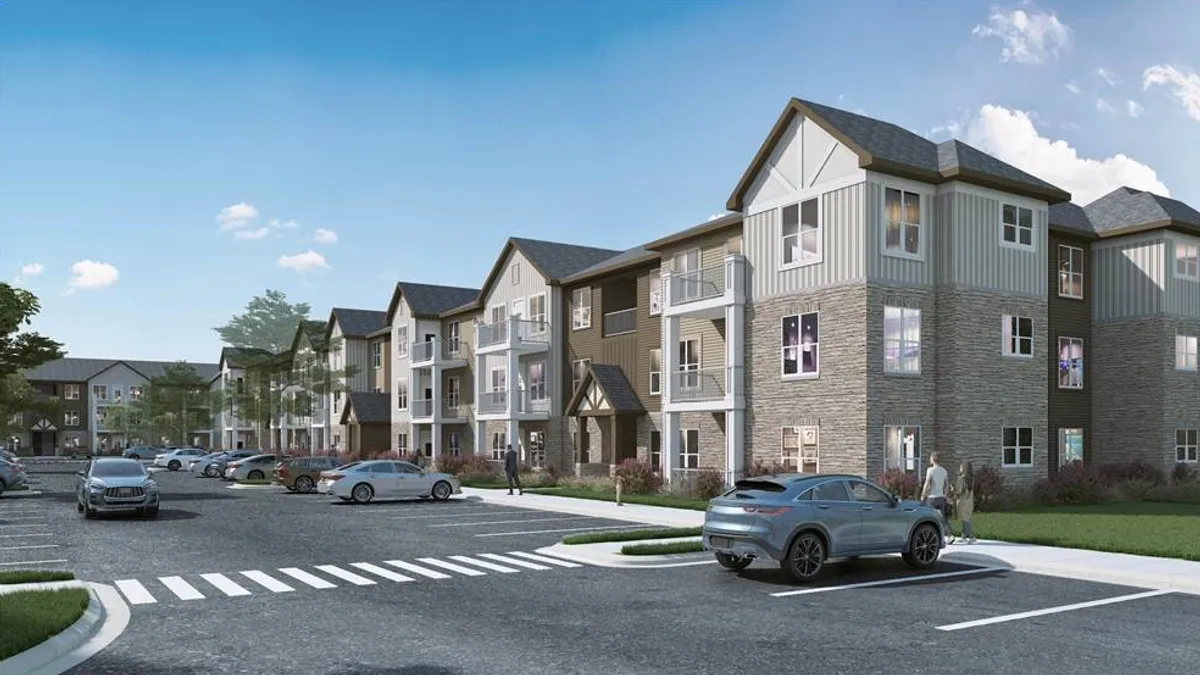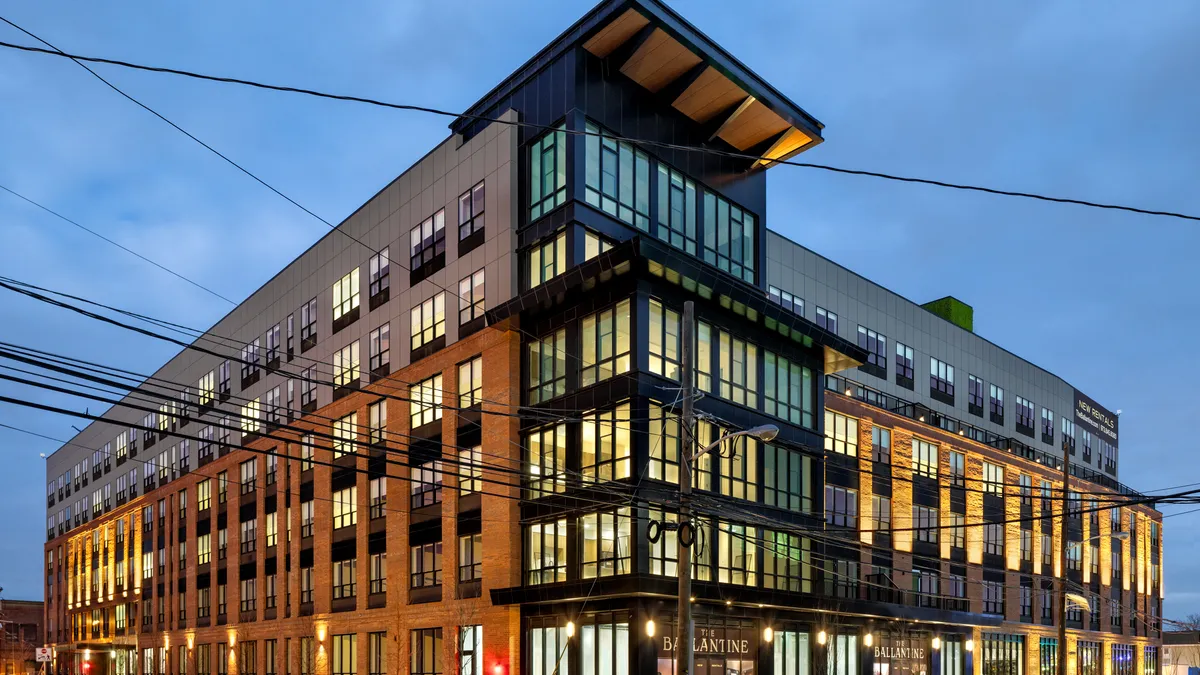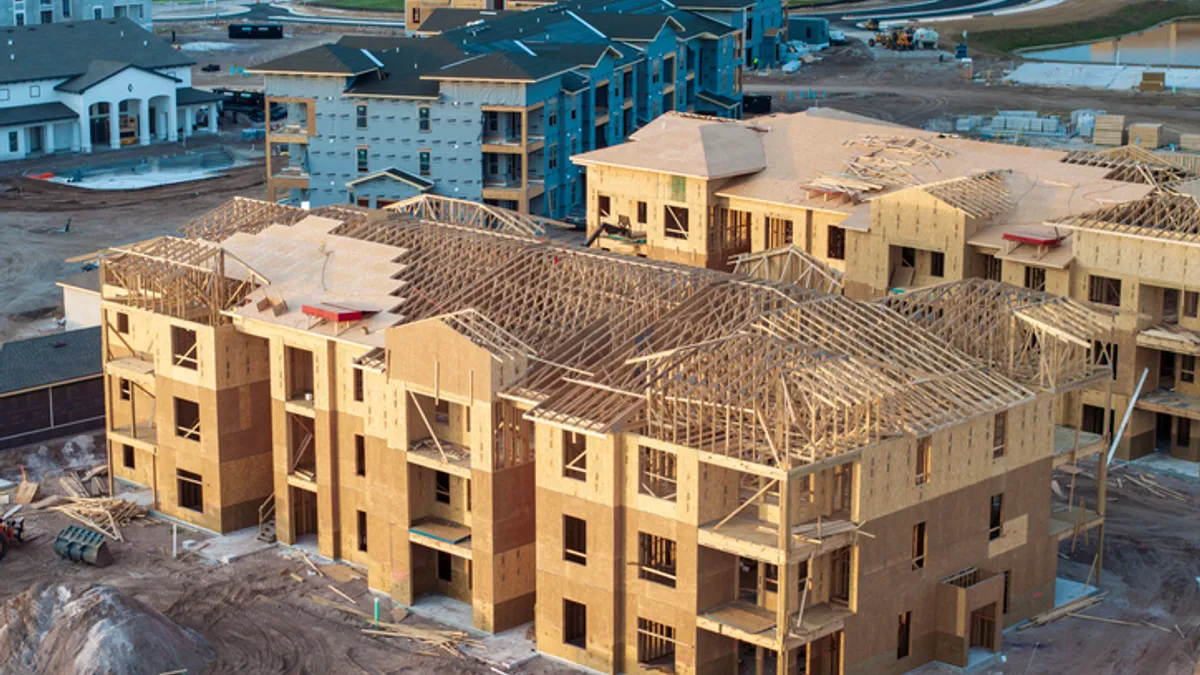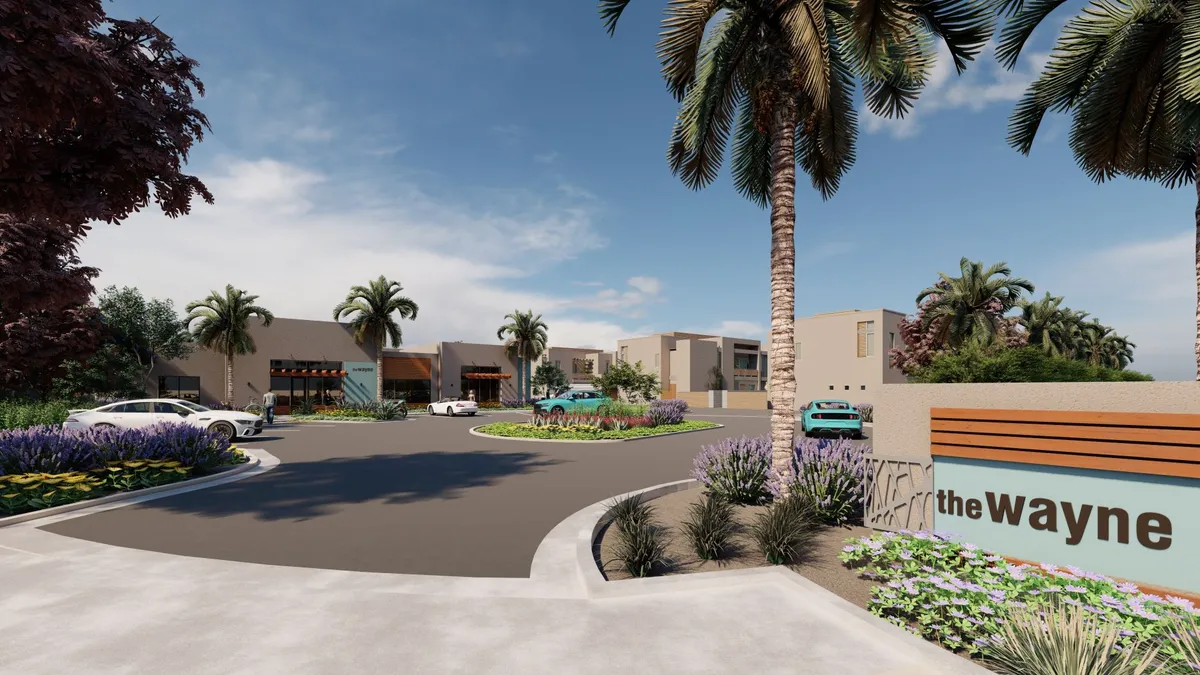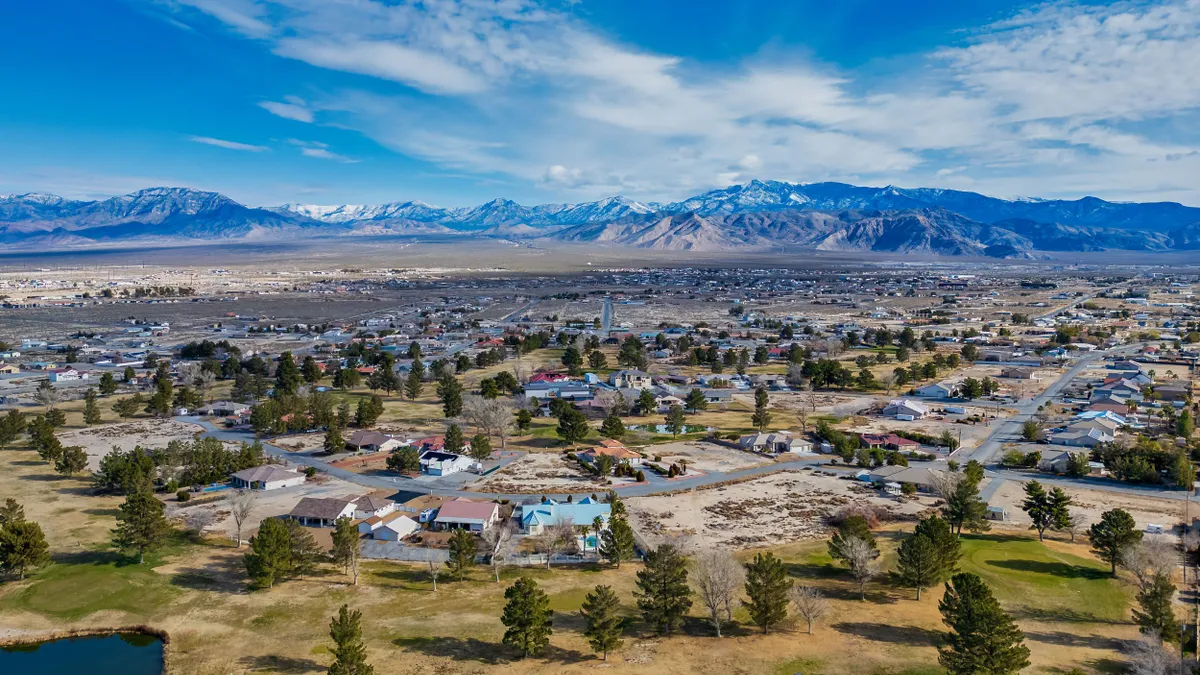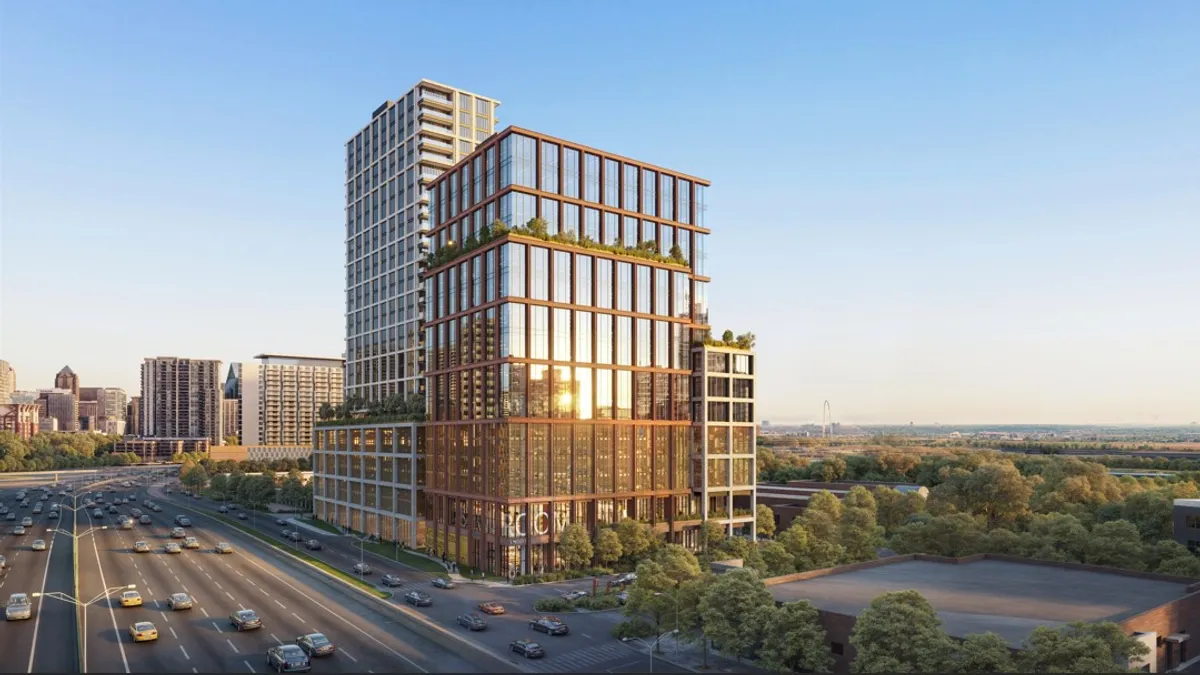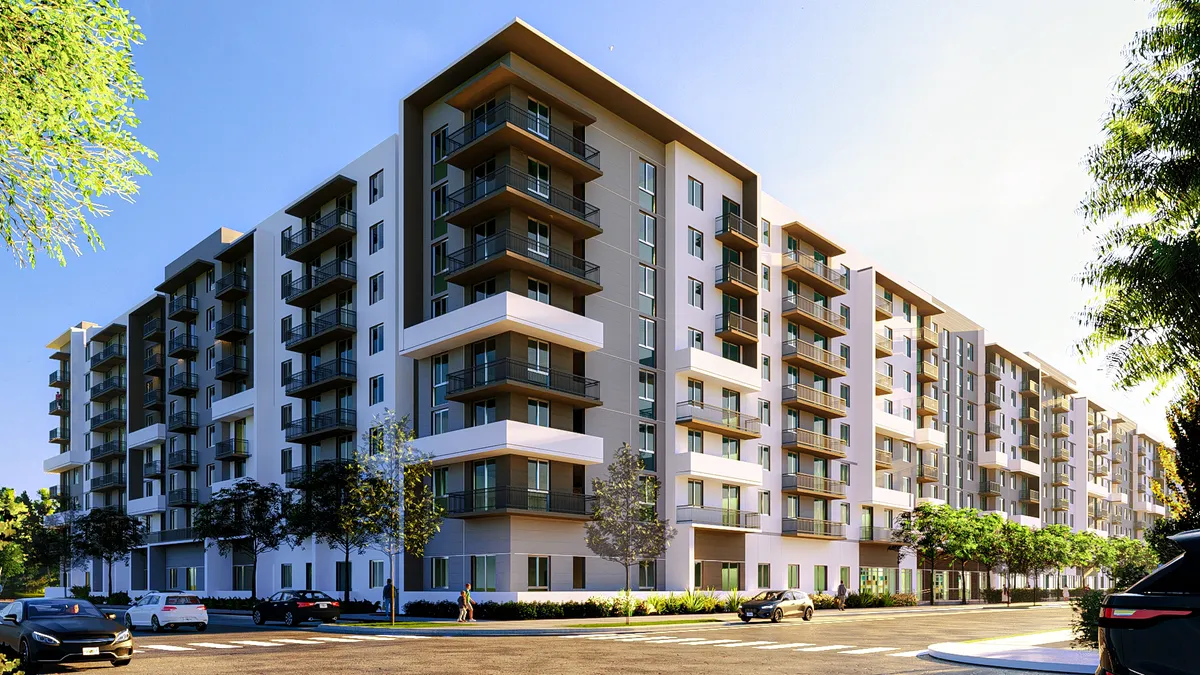While the COVID-19 pandemic has hammered many areas of commercial real estate, the multifamily sector has emerged as a clear winner.
Although apartment rents plummeted in the early months of the pandemic, they quickly recovered in early 2021. These rent increases set the stage for an equally robust sales market that drove up the prices of apartment communities. Rent and valuation growth, taken together, create fertile ground for development.
But just because apartments are making money doesn't mean the year ahead will be easy. Industry executives, particularly on the development side, see a number of challenges and opportunities in the new year. Here, Construction Dive looks at the most important factors for the multifamily sector in 2022.
Rent increases should moderate
The apartment industry's COVID-19 slump didn't last long. In the first quarter of 2021, demand doubled the usual 25,000 units normally seen during that time of the year. By the summer, the apartment industry was seeing record-high rent increases.
However, Joe Lubeck, CEO of Florida-based apartment owner and manager American Landmark Apartments, doesn't think these double-digit increases are sustainable into 2022, particularly with inflation.
"People are paying more for food, and more for gas and everything else," he said.
Jay Parsons, vice president and deputy chief economist at RealPage, agrees that rent growth may moderate this year.
"We're forecasting national growth in the high single digits," Parsons said. "Those are still big numbers by comparison of most years, but we probably won't be touching the 16% or 17% range we saw [in 2021]."
In some metros, another factor limiting growth could be rent control legislation. Measures capping increases emerged in a number of markets around the country. For example, in November, Minneapolis voters gave the city council the ability to put rent controls in place, while St. Paul residents passed a ballot measure to cap most rent increases at 3% annually.
Apartment industry trade groups say rent control legislation is on their radar in many other places, including Colorado, Nevada, Illinois, Washington, Massachusetts, Washington, Pennsylvania and even red states, like Kentucky and Florida.
"I think that what has traditionally been a coastal issue in New York, San Francisco and New Jersey has now entered the Midwestern space," said Greg Brown, senior vice president of government affairs for the Arlington, Va.-based trade group the National Apartment Association. "And that is cause for concern for us."
Values will rise
As rents continued to rise, the value of apartment properties also soared in 2021, increasing 16.8% from Oct. 2020 to Oct. 2021, according to New York-based research firm Real Capital Analytics (RCA) CCPI, which gauges the value of commercial real estate.
Even if rent increases are moderate in 2022, intense competition for apartments should continue to push prices up.
Right now, the number of investors in the market far outpaces the number of properties for sale.
"We see a demand for assets that outpaces the availability to buy them," said Charles Foschini, a senior managing director at New York-based apartment lender Berkadia's Mortgage Banking team.
However, that demand is squeezing some buyers. After purchasing 14 properties in the first eight months of 2021, Doug Root, co-founder and managing director of Arlington, Virginia-based apartment owner Blackfin, was only able to close one deal in the last quarter of 2021.
Some of the investment groups winning deals are relatively new entrants to the space.
"I think every day it seems like there's more private capital and syndicators and crowdfunders out there," said Matt Ferrari, co-chief investment officer and head of acquisitions and east coast asset management for California-based TruAmerica Multifamily, an active buyer in 2021.
While more investors are entering the space, there still aren't enough properties being built to meet their appetite. That lack of supply, coupled with increasing demand, is pushing prices upward.
"You have zoning restrictions limiting the amount of apartments [being built]," said Jim Costello, senior vice president for New York-based commercial real estate data firm Real Capital Analytics (RCA).
Apartment buildings will continue to sell
As rents boomed, so did apartment sales. The significant rent increases drew investors into the multifamily business from other real estate sectors and around the globe in 2020.
"Real estate is getting a lot of play," said Bobby Lee, CEO of Los Angeles-based apartment owner and manager JRK Property Holdings, which acquired 12 properties and sold two from January 2021 to early 2022. "And there are really only two safe places in real estate right now — industrial and multifamily. So, I think there is going to be a lot more capital coming into this space."
The popularity of apartments as an investment class showed up in the numbers. Before the end of November, $201.3 billion worth of apartments were sold nationally in 2021, according to RCA. By comparison, the industry's previous all-time high in transactions was $193 billion, posted in 2019.
Root predicts some buyers might pull back at the beginning of the year.
"It [the apartment sales market] had been on a tear," Costello said. "It struggled early in the pandemic, but it closed 2020 with a record high December deal volume. It was on fire, and in 2021, it has been off to the races."
"I think deal flow will be very light in the first quarter because it felt like the whole market was for sale at the tail end of this year," Root said. "If you were a seller, and certainly a private seller, there was a lot of appetite out there, and it made a lot of sense to take your deal to the market."
Others expect the flood of money chasing apartments and willing sellers to continue to power transactions in the year ahead.
"I just feel like 2022 is going to be even bigger than 2021," Lee said. "And I think 2023 could be sequentially another good year. You could have two more good years because you're going to have willing sellers."
Despite obstacles, developers will build apartments
With strong performance from both rents and sales, developers are eager to build more apartments. And debt and equity are lining up to get behind these deals.
"We've got so much equity chasing us right this minute," says Steve Hallsey, executive vice president of operations for Atlanta-based Wood Residential Service, the management arm of large developer Wood Partners. "We're just really trying to be very selective."
Permits, which are a good barometer of future production, continue to rise. In November, 560,000 multifamily units were permitted, a 6.1% increase from October and a 15% jump compared to the same period in 2020, according to RealPage.
In November, 560,000 multifamily units were permitted, according to the U.S. Census Bureau. This was an increase of 6.1% from October and a 15% jump from last year. Meanwhile, 491,000 multifamily units were started for the same period, up 12.1% from the (downwardly revised) October annual rate, and a 39.1% increase from November 2020.
Still, getting projects started to meet the demand continues to be a challenge. Adam David Lynd, president and CEO for Shavano Park, Texas-based apartment developer, manager and owner of The Lynd Co., has seen prices for multiple products dramatically increase over the last couple of years.
"Costs are through the roof — everything from flooring to roofing to shingles to glass," Lynd said. "The supply chain shortage is really hurting everybody."
Construction challenges will continue
If that's not enough, labor prices have also risen in the past year.
"The labor availability situation seems to be getting worse," said Ken Simonson, chief economist for The Associated General Contractors of America. "While demand for apartments looks like it's holding up very well, it's going to be very challenging to produce them and bring them in on time and budget."
Land also continues to be a challenge. In fact, it's an issue for all types of residential rental properties, according to Joe Morrison, president of Myrtle Beach, South Carolina-based Sands Cos., a construction company and developer that builds apartment-style cottages in the Southeast.
"It's very competitive," Morrison said. "It's like you're getting interviewed by the sellers now… They're doing background checks of who you are and what you've done to make sure you can perform and build a product that you say you're going to build."
Legislation could help
While the industry is prepared to combat rent control, it welcomes some other government action. A few local, state and federal governments enter 2022 looking at ways to make apartment building easier. With shortages of housing and rising costs, some local governments are looking at more supply as an answer. To achieve that goal, they're making the process of building easier.
For instance, Minneapolis has removed single-family zoning to allow for more dense housing. Other localities, like Mongomery County, Maryland, are considering making it easier to add density in single-family communities.
"In California, they're trying to do much more of a carrot-and-stick approach," said Jim Lapides, a vice president at Washington, D.C.-based trade group the National Multifamily Housing Council. "They're actually trying to use a stick this time to encourage more housing development. So, I think we're seeing more of that around the country."
On the national level, the bipartisan Yes In My Backyard (YIMBY) Act has the potential to stimulate more development by encouraging localities to cut regulations.
"I think what's most heartening is that so much of the conversation has changed around this issue of affordability and that people realize we need to add more supply," Lapides said.
Click here to sign up to receive multifamily and apartment news like this article in your inbox every weekday.



